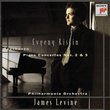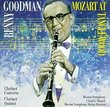| All Artists: Sergey Rachmaninov, Alexandre Rabinovitch, Martha Argerich Title: Rachmaninov:Suite Nos.1 & 2/Symphonic Dances Members Wishing: 0 Total Copies: 0 Label: Teldec Release Date: 7/7/1992 Genres: Dance & Electronic, Classical Styles: Historical Periods, Modern, 20th, & 21st Century, Instruments, Keyboard Number of Discs: 1 SwapaCD Credits: 1 UPC: 090317471723 |
Search - Sergey Rachmaninov, Alexandre Rabinovitch, Martha Argerich :: Rachmaninov:Suite Nos.1 & 2/Symphonic Dances
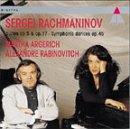 | Sergey Rachmaninov, Alexandre Rabinovitch, Martha Argerich Rachmaninov:Suite Nos.1 & 2/Symphonic Dances Genres: Dance & Electronic, Classical
|
Larger Image |
CD DetailsSimilarly Requested CDs
|
CD ReviewsAmple Virtuosity Sometimes Misses the Point Daniel J. Rose | Shrewsbury, MA USA | 06/30/2002 (4 out of 5 stars) "This is one of the two finest performances of these pieces in recent record. For that, it is perhaps the most overtly virtuosic of the lot, with Martha Argerich and Alexandre Rabinovitch (Ar/R) perfectly matched in skill and musical temperament.The other finest performance of these pieces is the recording by Vladimir Ashkenazy and Andre Previn (As/P)(London/Decca 444 845-2), older than Ar/R by over 10 years for Op. 45 and by over 15 years for Op. 5 and Op. 17. While Ar/R play with the kind of breathtaking technique that keeps you on the edge of your seat, and certainly show great sympathy with the emotions aroused by this music, they sometimes either miss an important musical point or emphasize the point out of proportion to its place in the musical texture. It is the As/P recording (and at least one other recording of Op. 45 by a husband/wife team that is now out of print on Vox/Turnabout) that so well makes these points and reveals the shortcomings in Ar/R.With Ar/R, there is noticably equal weight given to their parts by both performers almost all of the time. In a curious way, this emphasizes the virtuosity of both performers, and in so doing, one really does hear both performers as individuals, even though it is often difficult to know (without a score) who is playing what part. On the other hand, with As/P, each performer hands off the prominance of their part to the other (presumably according to the score), and they do it with such fluid and seamless ease that they leave two strong impressions: 1) the unity of their ensemble and 2) a powerful understanding of the structural and expressive points in the score, which they convey clearly. Basicly, As/P sound together like a single performer on one "grand" piano, where as Ar/R sound like two superbly matched and gifted performers on separate pianos, each matching the other in prominance and expressiveness, which does not necessarily accurately serve the score and its inherent beauty.Let me emphasize that As/P peform flawlessly and with more than enough virtuosity to stir one's more exuberant emotions. But Ar/R really do take it to the limit, in terms of speed, dynamics, changes of speed and dynamics, and all combined with flawless accuracy with the notes. However, the total sound of Ar/R often loses some beautifully rendered harmonic and melodic counterpoint that As/P almost always reveal.Certainly, Ar/R also benefit from more modern recording technology that gives their performances greater presence. However, the sound recording for As/P is still first rate for its time and certainly does not hide any of the musical nuance that they bring to their performances.Frankly, I recommend both the present Argerich/Rabinovitch and the comparable Ashkenazy/Previn performances for their unique qualities, as they both hit a "chord" in their own way. However, you will listen depending on your goal. If you want to be swept off your feet and driven wild, Argerich/Rabinovitch is your choice of the moment. If you want a no less competent, yet more studied and deeply moving experience that lingers long after you hear it, your choice is clearly Ashkenazy/Previn." Exqusite Rachmaninoff Terry C. Kildal | Seattle, WA USA | 09/04/2004 (5 out of 5 stars) "Both of the suites recorded here are amazing. The playing is technically unparalleled, though at times I agree with the other reviewer that we sometimes miss emotional heart in some spots. I also own the Ashkenazy Previn set and it compliments this set well. The sound quality here is outstanding, in stark contrast to the older Ashkenazy set. To get the full picture of this music own both sets. Both get 5 stars for different reasons." Very exciting, if you can stand all the crash and bang Santa Fe Listener | Santa Fe, NM USA | 01/09/2006 (3 out of 5 stars) "Some of the pianism here is so painfully brutal that it made Rachmaninov's lush scores sound like the kind of torture music the police use in hostage situaitons to break down the criminals. Since Argerich is a well known anarchist, no doubt she instigated the violence, though Rabinovitch willingly collaborates. The worst offense is in the opening of the Symphonic Dances--if you can stand taht, you are home free.
I wish I could stand it, becasue every note of the playing in both Suites and the Symphonic Dances is so origianl and intense that it leaves the old standbys, Previn and Ashkenazy (Decca), in the shade. It's typical of Argerich to do this, finding new insights and spoiling them a bar later with incendiary assault. Her admirers love her for it. I cirnge when the bombs fall, so this isn't my ideal performance of these two-piano masterpieces. The recorded sound is clear but edgy, making the percussive playing that much more nerve-wracking." |

 Track Listings (11) - Disc #1
Track Listings (11) - Disc #1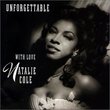
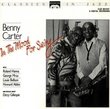

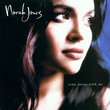


![Moulin Rouge, Vol. 2 [Music from the Motion Picture]](https://nationalbookswap.com/cd//m/76/3176/573176.jpg)
